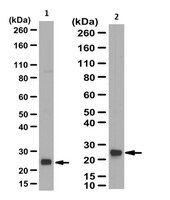Susceptibility of Nrf2-null mice to steatohepatitis and cirrhosis upon consumption of a high-fat diet is associated with oxidative stress, perturbation of the unfolded protein response, and disturbance in the expression of metabolic enzymes but not with insulin resistance.
Meakin, PJ; Chowdhry, S; Sharma, RS; Ashford, FB; Walsh, SV; McCrimmon, RJ; Dinkova-Kostova, AT; Dillon, JF; Hayes, JD; Ashford, ML
Molecular and cellular biology
34
3305-20
2014
概要を表示する
Mice lacking the transcription factor NF-E2 p45-related factor 2 (Nrf2) develop more severe nonalcoholic steatohepatitis (NASH), with cirrhosis, than wild-type (Nrf2(+/+)) mice when fed a high-fat (HF) diet for 24 weeks. Although NASH is usually associated with insulin resistance, HF-fed Nrf2(-/-) mice exhibited better insulin sensitivity than HF-fed Nrf2(+/+) mice. In livers of HF-fed mice, loss of Nrf2 resulted in greater induction of lipogenic genes, lower expression of β-oxidation genes, greater reduction in AMP-activated protein kinase (AMPK) levels, and diminished acetyl coenzyme A (CoA) carboxylase phosphorylation than in the wild-type livers, which is consistent with greater fatty acid (FA) synthesis in Nrf2(-/-) livers. Moreover, primary Nrf2(-/-) hepatocytes displayed lower glucose and FA oxidation than Nrf2(+/+) hepatocytes, with FA oxidation partially rescued by treatment with AMPK activators. The unfolded protein response (UPR) was perturbed in control regular-chow (RC)-fed Nrf2(-/-) mouse livers, and this was associated with constitutive activation of NF-κB and JNK, along with upregulation of inflammatory genes. The HF diet elicited an antioxidant response in Nrf2(+/+) livers, and as this was compromised in Nrf2(-/-) livers, they suffered oxidative stress. Therefore, Nrf2 protects against NASH by suppressing lipogenesis, supporting mitochondrial function, increasing the threshold for the UPR and inflammation, and enabling adaptation to HF-diet-induced oxidative stress. | 24958099
 |
Regulation of mouse glutathione S-transferases by chemoprotectors. Molecular evidence for the existence of three distinct alpha-class glutathione S-transferase subunits, Ya1, Ya2, and Ya3, in mouse liver.
McLellan, LI; Kerr, LA; Cronshaw, AD; Hayes, JD
The Biochemical journal
276 ( Pt 2)
461-9
1991
概要を表示する
Liver cytosol from mice fed on a normal diet contains Alpha-class glutathione S-transferase (GST) subunits of Mr 25,800, Mu-class GST subunits of Mr 26,400 and Pi-class GST subunits of Mr 24,800. Feeding female mice with a diet containing the anticarcinogenic antioxidant butylated hydroxyanisole (BHA) causes induction of the constitutively expressed Mu-class and Pi-class subunits. BHA also induces an Alpha-class GST comprising subunits of Mr 25,600, which is not expressed at detectable levels in normal mouse liver [McLellan & Hayes (1989) Biochem. J. 263, 393-402]. Data are now presented that show that administration of the anticarcinogen beta-naphthoflavone (BNF), like BHA, induces the Alpha-class 25,600-Mr subunits but not the constitutive Alpha-class GST with subunits of Mr 25,800. The effects of BNF on expression of hepatic GST were studied in both DBA/2 and C57BL/6 mice; these studies revealed a preferential induction of the Alpha-class 25,600-Mr subunits and of the Pi-class 24,800-Mr subunits in those mice in possession of a functional Ah receptor. The BHA/BNF-inducible Alpha-class GST can be resolved into two separate, non-interconvertible peaks by reverse-phase h.p.l.c. Automated amino acid sequence analysis of CNBr-derived peptides from each of these h.p.l.c.-purified peaks showed that the peaks contained at least two very similar subunits. These have been named Ya1 and Ya2. The amino acid sequence of the Ya1 subunit was compared with sequences deduced from a genomic clone, lambda mYa1 (Daniel, Sharon, Tichauer & Sarid (1987) DNA 6, 317-324], and a cDNA clone, pGT41 [Pearson, Reinhart, Sisk, Anderson & Adler (1988) J. Biol. Chem. 263, 13324-13332]. Our data suggest that the Ya1 subunit represents the subunit encoded by the genomic clone, lambda mYa1. Sequence analysis of the constitutive Alpha-class Ya3 subunit (Mr 25,800) shows that, although it is a member of the same gene family as the Ya1 and Ya2 subunits, it represents a distinct sub-family of Alpha-class GST, containing subunits that are more similar to rat Yc. Our data indicate that, of these Alpha-class GST subunits, the two with Mr 25,600 (Ya1 and Ya2) are selectively induced by BHA or BNF in mouse liver; neither BHA nor BNF induces significantly the GST subunit with Mr 25,800 (Ya3). | 2049074
 |
Differential induction of class alpha glutathione S-transferases in mouse liver by the anticarcinogenic antioxidant butylated hydroxyanisole. Purification and characterization of glutathione S-transferase Ya1Ya1.
McLellan, LI; Hayes, JD
The Biochemical journal
263
393-402
1989
概要を表示する
A novel cytosolic Alpha class glutathione S-transferase (GST) that is not normally expressed in mouse liver was found to be markedly induced (at least 20-fold) by the anti-carcinogenic compound butylated hydroxyanisole. This enzyme (designated GST Ya1 Ya1) did not bind to either the S-hexylglutathione-Sepharose or the glutathione-Sepharose affinity matrices, and purification was achieved by using bromosulphophthalein-glutathione-Sepharose. The purified isoenzyme, which comprises subunits of Mr 25,600, was characterized, and its catalytic, electrophoretic, immunochemical and structural properties are documented. GST Ya1 Ya1 was shown to be distinct from the Alpha class GST that is expressed in normal mouse liver and is composed of 25,800-Mr subunits; the Alpha class isoenzyme that is constitutively expressed in the liver is now designated GST Ya3 Ya3. Hepatic concentrations of GST Ya3 Ya3 were not significantly affected when mice were treated with butylated hydroxyanisole. Both Pi class GST (subunit Mr 24,800) and Mu class GST (subunit Mr 26,400) from female mouse liver were induced by dietary butylated hydroxyanisole. By contrast, hepatic concentrations of microsomal GST (subunit Mr 17,300) were unaffected. | 2597111
 |











